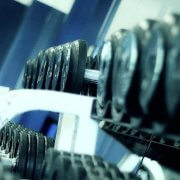Is Floor Hockey a Sport? Let’s Find Out!

The Sport Of Floor Hockey
You are probably most familiar with the game and sport of ice hockey, the globally recognized game that is played with two teams skating on an ice rink trying to score goals against the other team. However, are variations such as floor hockey considered a sport?
Floor hockey is a sport that is played similar to ice hockey and is an overarching term for many different variations. Each of which is competitively played with two teams against each other and has the primary goal of winning by getting more goals into the other team’s net.
There are many different floor hockey variations, and each of them comes with some unique rules or variations. If you want to learn more about the different floor hockey types, how exactly it is considered a sport, and some of the different levels and leagues of floor hockey that exist, keep reading the article below.
What Is Floor Hockey?
Floor hockey consists of different hockey variations that are played either indoors or outdoors, all of which are adaptations of the sport you are already familiar with, ice hockey.
Different Variations of Floor Hockey
The different variations of floor hockey are:
- Floorball: This type of floor hockey is played indoors and is especially popular in nordic countries. This version is played off the ice without skates, where five players play on the field alongside a goalkeeper. The game is similar to ice hockey, where three twenty-minute periods occur, and the goal is to get a plastic ball into the net in various ways, including using their feet.
- Roller hockey: This variation is played on a dry field with roller skates. It also includes rink hockey or inline hockey, but the differences are based on the types of sticks and skates used. Each team consists of five players, with four being skaters and one the goalie.
- Ball hockey: This variation is similar to ice hockey, but the difference is players don’t play on the ice, are on their feet, and play with a ball. With five players and one goalie, the point is to get the most goals in the opposing team’s net.
- Street hockey: Derived from ice hockey, street hockey (sometimes referred to as dek hockey, ball hockey, or road hockey) is played on asphalt or cement, where the players are typically outdoors with just shoes on. Some may also wear inline skates. The game uses the same sticks as ice hockey, and people choose to either use a puck or a ball to play the game. You can play it for fun or at a tournament level. We’ve also got an article on a similar topic, covering if street hockey is also considered a sport.
- Indoor field hockey: This indoor sport was derived from field hockey and is played indoors. It is played with smaller goalposts, no out-of-bounds areas, different ice hockey sticks, and is played using balls. Each team consists of five players on the field with an additional as the goalkeeper. The goal is to score the most goals on the other team’s net.
- Unicycle hockey: This variation is similar to roller hockey. However, players ride a unicycle instead and use tennis balls and ice hockey sticks to score goals. This unique game has five players on at a time, with some choosing to have goalkeepers and others not.
- Custom hockey: This variation of floor hockey uses plastic sticks and an orange plastic puck. Typically, you will find this sport being played in elementary and high schools as it has similar concepts to ice and ball hockey but is made to be more accessible for kids.
- Gym ringette: This variation can be played on or off an ice rink, where players use skates, a rubber ring, and a straight stick with a drag-tip made of plastic. The game is played with two opposing teams, where players are to get as many goals as possible against the opposing team.
Most of these variations are played relatively similarly, with all of them having the main objective of getting some object, a puck, ball, or ring, into the opposing team’s net using a variation of an ice hockey stick or an ice hockey stick itself.
Two teams will then face-off against each other at a race against a clock to get more goals into the opposing team’s net. The team with the most goals against the opposing team at the end of the game is declared the winner.
In many cases, these versions can be played for fun, in a school gym class, or even in a league that plays nationally or even internationally recognized tournaments.
The Rules of Floor Hockey
Although each floor hockey variation has its own set of rules, there are basic rules that are followed regardless of the codes set in place for each.
First and foremost, how the winner is declared remains the same and is based on the number of goals. However, you may find different rules within each variation of how you can score goals. For example, floorball allows players to use their feet to pass the ball, but they cannot do it twice in a row.
Other rules that are generally the same include:
- Shootouts: This occurs when the game has gone into overtime because of a tie, but the tie has yet to be broken.
- Penalties: This is when a major infraction in the play has occurred. This includes tripping another player, slashing another player with the stick, or hitting another player from behind, which results in one or multiple players being required to sit out of the game for a certain amount of time.
- No contact: While this may vary, since less equipment is typically used in floor hockey variations, the no contact rule is in place for the safety of players. For a deeper dive on this topic, be sure to read our article looking into floor hockey’s contact rules.
Can You Competitively Play Floor Hockey?
While all of the floor hockey variations are competitively played variations of the globally recognized game and sport of ice hockey, does this make it a sport?
By definition, a sport is an activity that involves physical exertion and skill, where an individual or a team competes against another team for entertainment purposes. With this in mind, all of the variations of floor hockey are considered a sport.
This also means that each variation can be competitively played, and in most cases, there are leagues for each variation. Depending on the sport’s variation, however, the types of tournaments, number of tournaments, and styles of tournaments differ. A different organization is also responsible for governing each of these sports, and you may only find this in certain countries.
Floor hockey is organized by the International Floorball Federation, where floorball championships are held every two years. Street hockey is governed by the International Street and Ball Hockey Federation, where tournaments are held annually worldwide. Unicycle hockey is governed by the International Unicycling Federation, where you can find leagues in the UK, Germany, and Switzerland.
Currently, floor hockey is only played as an Olympic sport in the Special Olympics. It is played similar to the gym ringette, with a straight stick and a ring with concepts similar to ice hockey.
F
Final Thoughts
The variations of floor hockey are all adaptations of ice hockey that have the same basic objective and concepts at the center of it. Each of which consists of having two teams of players use a form of a stick, a puck, ball, or ring to compete against each other to get the most goals against the opposing team.
With all of these being competitive, of course, they are sports as they require each team to compete against another team and, hopefully, win the game.
Sources
- Topend Sports: About Floor Hockey
- RCFHA: FAQ
- Wikipedia: Ringette
- Wikipedia: Floor Hockey
- Special Olympics 2020: Floor Hockey




